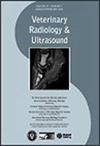Prevalence of presumed endplate junction failure at the lumbosacral intervertebral junction in dogs on computed tomography
IF 1.3
2区 农林科学
Q2 VETERINARY SCIENCES
引用次数: 0
Abstract
Lumbosacral intervertebral disc herniation (IVDH) is a common cause of lower back pain in dogs and humans. In humans, the vertebral endplate to annulus fibrosus (AF) attachment was implicated as an alternative failure site besides rupture through the dorsal AF (AFF). Endplate junction failure (EPJF) is characterized by IVDH, accompanied by endplate irregularities (type A), rim avulsions (type B), or larger bony avulsions on one (type C) or both endplates (type D), associated with an adjacent endplate defect. This retrospective study reports the CT prevalence of presumed EPJF in dogs and its associations with signalment and other lumbosacral CT abnormalities. CT scans, including the lumbosacral spine of dogs obtained at two institutions, were assessed, yielding 324 scans. Presumed EPJF was found in 69 dogs (21%) and AFF in 68 dogs (21%), commonly at the caudal endplate of the last lumbar vertebra (71%). The remaining 187 dogs did not show presumed EPJF or AFF. Presumed EPJF type A occurred in 49/69, type B in 19/69, and type C in 1/69 dogs. Univariable logistic regression showed that presumed EPJF was associated with significantly higher IVDH grades than AFF. In the multiple regression model, presumed EPJF and AFF remained associated with increasing age and spondylosis deformans. Presumed EPJF was associated with vertebral endplate sclerosis and AFF with zygapophyseal joint osteoarthritis. In conclusion, presumed EPJF was observed on CT in 21% of dogs with lumbosacral IVDH. Prospective studies correlating EPJF on CT with clinical, surgical, and histopathological findings are needed for a better understanding of the underlying pathology and clinical relevance.通过计算机断层扫描推测狗腰骶椎椎间关节内板连接失败的发生率
腰骶椎间盘突出症(IVDH)是导致狗和人类下背部疼痛的常见原因。在人类中,椎体终板与纤维环(AF)的连接被认为是背侧 AF(AFF)破裂以外的另一个失效部位。椎体终板连接失败(EPJF)的特征是IVDH,伴有终板不规则(A型)、边缘撕脱(B型)或一个(C型)或两个终板(D型)较大的骨性撕脱,并伴有邻近终板缺损。这项回顾性研究报告了推测的 EPJF 在犬中的 CT 患病率及其与信号和其他腰骶部 CT 异常的关联。研究人员评估了在两家机构获得的包括犬腰骶椎在内的 324 份 CT 扫描结果。在 69 只狗(21%)中发现了推测的 EPJF,在 68 只狗(21%)中发现了 AFF,常见于最后一节腰椎的尾椎终板(71%)。其余 187 只狗没有出现推测的 EPJF 或 AFF。推测的 EPJF A 型发生在 49/69 只犬中,B 型发生在 19/69 只犬中,C 型发生在 1/69 只犬中。单变量逻辑回归显示,推定 EPJF 与 IVDH 分级明显高于 AFF 相关。在多元回归模型中,推测的 EPJF 和 AFF 仍与年龄增长和脊柱畸形有关。假定的EPJF与椎体终板硬化有关,而AFF与颧骨关节骨关节炎有关。总之,21% 的腰骶部 IVDH 患犬可在 CT 上观察到假定的 EPJF。需要进行前瞻性研究,将 CT 上的 EPJF 与临床、手术和组织病理学结果联系起来,以便更好地了解潜在的病理和临床意义。
本文章由计算机程序翻译,如有差异,请以英文原文为准。
求助全文
约1分钟内获得全文
求助全文
来源期刊

Veterinary Radiology & Ultrasound
农林科学-兽医学
CiteScore
2.40
自引率
17.60%
发文量
133
审稿时长
8-16 weeks
期刊介绍:
Veterinary Radiology & Ultrasound is a bimonthly, international, peer-reviewed, research journal devoted to the fields of veterinary diagnostic imaging and radiation oncology. Established in 1958, it is owned by the American College of Veterinary Radiology and is also the official journal for six affiliate veterinary organizations. Veterinary Radiology & Ultrasound is represented on the International Committee of Medical Journal Editors, World Association of Medical Editors, and Committee on Publication Ethics.
The mission of Veterinary Radiology & Ultrasound is to serve as a leading resource for high quality articles that advance scientific knowledge and standards of clinical practice in the areas of veterinary diagnostic radiology, computed tomography, magnetic resonance imaging, ultrasonography, nuclear imaging, radiation oncology, and interventional radiology. Manuscript types include original investigations, imaging diagnosis reports, review articles, editorials and letters to the Editor. Acceptance criteria include originality, significance, quality, reader interest, composition and adherence to author guidelines.
 求助内容:
求助内容: 应助结果提醒方式:
应助结果提醒方式:


